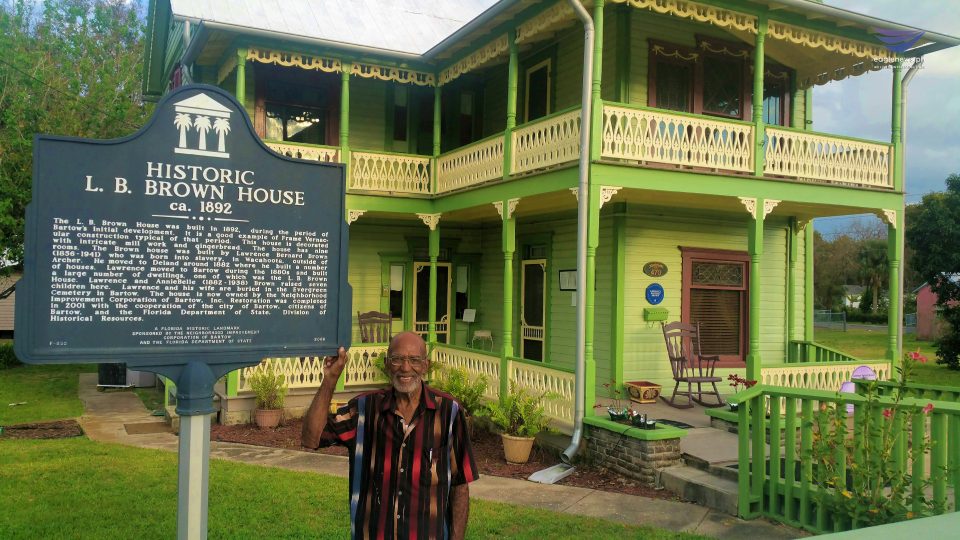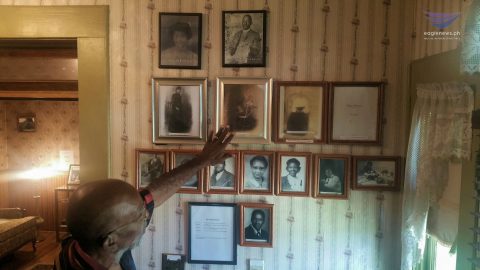
By Melissa Sarmiento Allen
EBC Florida Bureau
POLK COUNTY, Florida (Eagle News) – Along an unassuming street in the quaint town of Bartow sits one of Florida’s historical crown jewels, The L.B. Brown House, which is listed in the National Register of Historic Places and named after its builder and original owner, Lawrence Bernard Brown, an African-American who was born into slavery in 1856.
Despite having limited formal schooling, Brown was something of a Renaissance man, skilled in many areas including cabinetry, furniture repair, mirror silvering, umbrella repair, and calligraphy. The former slave most notably became a successful entrepreneur, as well as a self-taught master carpenter and home builder, and in 1892 constructed the historic piece of wood-frame vernacular architecture himself. Brown also built an estimated 50 to 75 bungalow houses in his lifetime.
“He started out with nothing and really was a self-made man. When you think of the economy of this area in the 1920s and 1930s, Brown wouldn’t have been just one of the richest black men, he would’ve been one of the richest men period,“ said Clifton Lewis, the founding president of the L. B. Brown Museum as well as its principal docent and curator. Lewis is also the president of the Neighborhood Improvement Corporation of Bartow Inc., the organization that currently owns the house.
The two-story, nine-room Victorian style house evokes the charm of a bed and breakfast with its gingerbread trim, floral wallpaper, and wrap-around porches on both levels. The hand-beveled moldings, baseboard corner blocks, and hand-silvered mirrors throughout the house were all handcrafted by Brown and show the high level of skill and attention to detail that he possessed. Even the foundation stones, blocks, and bricks were manufactured by Brown.
“There were no Lowes or Home Depots around back then, so if you wanted something you had to make it yourself,” Lewis said.
Lewis, a 76-year-old Bartow resident and Louisiana native, is a self-described “lover of history” who retired almost 30 years ago from a long career in telecommunications in Washington D.C. Shortly after relocating to Bartow, he discovered the house and its history–almost by accident.
“I saw this old house and that it had been abandoned. I had no idea that it was owned by a black man and certainly didn’t know it was built by a black man but I loved the architecture in spite of its condition and appearance,” said Lewis. “I recognized it’d be something of value.”
After finding the house, Lewis then set forth to acquire the property and start the restoration process. Little did he know that the house had great historical significance.
“Shortly after becoming acquainted with the house, I was told by my wife [a Bartow native] that it was Ms. Thomas’ house, a schoolteacher in Bartow,” said Lewis. “Everyone referred to that house as Ms. Thomas’ house.”
At the time, Lewis did not know that Ms. Thomas was the daughter of the man who built and owned the house. Lewis would soon learn that she had a brother named Robert who was living in New York. Upon learning of Lewis’ plans for the house, Robert agreed to come to Florida and talk about the restoration.

It was during the course of their conversations that the house’s historical importance was revealed. Lewis described how he was astounded when we learned that it was Robert’s father, a former slave, who not only owned the house but also built it.
“That was really a shocker to me because we were just wanting to restore the house for its beauty,” said Lewis.
The authenticity of Robert’s claim was soon proven with well-preserved records showing the house’s original builder and owner, along with supporting testimonials from neighbors who knew Lawrence Brown. “[L. B. Brown] left deep footprints. The things that he did were all well documented,” said Lewis.
In 2001, the restoration of the L. B. Brown House was completed and it is likely the only remaining intact house in the entire state built and owned by a former slave. Artifacts from the house are also on exhibition at the Smithsonian National Museum of African American History and Culture in Washington D.C.
According to Lewis, the majority of visitors come from outside Polk County, out-of-state and outside the country.
He touched on why people should take the time to visit historic places and museums.
“Just imagine trying to describe this house that was built by a black man born in slavery if it didn’t exist,” said Lewis. “The grandeur of it, the sturdiness of it, the architecture–it would be virtually impossible.”
Lewis added that people can learn so much more by visiting historical sites.
“Our kids have gotten away from the intellectual rigor, they’re not really getting into the history, they’ll just Google something. So hopefully this can inspire folks, young people in particular, to dig a little deeper,” Lewis said.
For the past two decades, Lewis has spent much of his retirement years working towards the preservation of the house and emphasized its importance not just to the local community, but to the nation.
“It is such an integral part of Bartow, Polk County, Florida, and American history,” said Lewis. “We refer to it as black history, but it is every bit of Florida history, and of American history.”
For more information on the L. B. Brown House, visit http://www.lbbrown.com.
(Eagle News Service)
